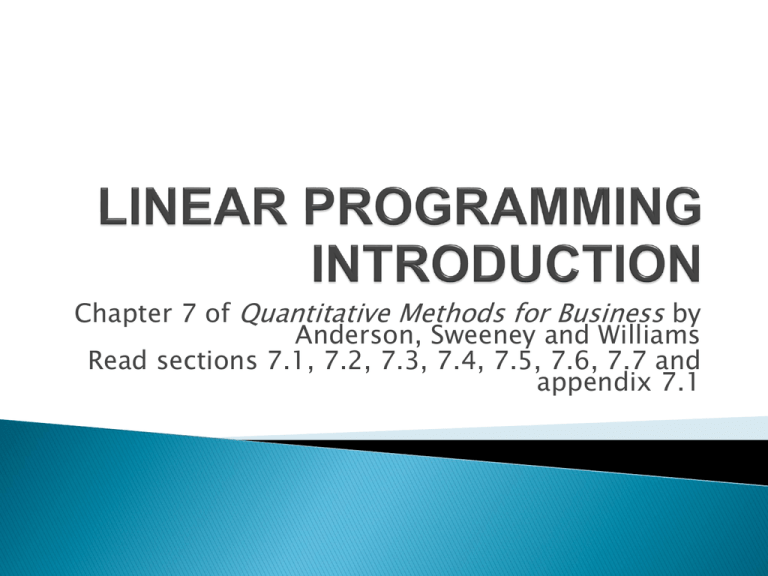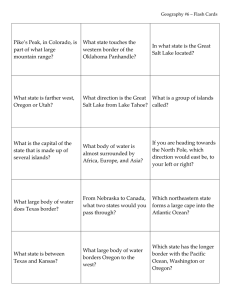LinearProgramming Intro Blackboard
advertisement

Chapter 7 of Quantitative Methods for Business by Anderson, Sweeney and Williams Read sections 7.1, 7.2, 7.3, 7.4, 7.5, 7.6, 7.7 and appendix 7.1 One of the most widely used M.S. tools Used to solve a wide variety of problems • • • • • • • Human Resource Scheduling Routing of Delivery Vehicles Selection of Advertising Media Planning Product Levels in Manufacturing Blending in Oil Refineries Selection of Investment Opportunities and many, many more Most widely used solution technique: The Simplex Method • Developed by George Dantzig in the 1940’s • First used to solve military operations problems during WWII • Coincided with the development of the first widely used computers Objective is to minimize or maximize some linear function of the decision variables Constraints are linear equations or inequalities Before the next class, you should complete the following homework problems in chapter 7 #1 Extremely large models easily solvable using existing computer programs Consider using L.P. Models whenever you are faced with allocating scarce resources among competing activities 3 Steps to Formulate A Linear Programming Problem: 1. DEFINE DECISION VARIABLES 2. FORMULATE OBJECTIVE 3. IDENTIFY CONSTRAINTS A glass company is considering using its excess capacity to manufacture two new products: • wood frame windows, which earn $3 profit each, and • aluminum frame doors which earn $5 profit, each. There are • 4 man-hours / day available in plant 1 (Plant 1 is used for wood frames) • 12 man-hours / day available in plant 2 (Plant 2 for aluminum frames) • 18 man-hours / day available in plant 3 (Plant 3 for glass and assembly) Each unit of the new products would require the following plant resources (in man-hours): WINDOWS PLANT 1 1 PLANT 2 -PLANT 3 3 DOORS -2 2 Formulate the problem: 1. DEFINE DECISION VARIABLES 2. OBJECTIVE FUNCTION 3. IDENTIFY CONSTRAINTS 1. 2. 3. Associate the horizontal axis with one decision variable, and associate the vertical axis with the other. Draw the constraints. Identify the feasible region as the area where all the constraints intersect (are “satisfied”). 4. Find the optimal solution (the feasible point which gives the best value of the objective). a. Graph the objective function line for any 2 arbitrary values of Z b. Identify the improving direction for Z c. Move a pen parallel to the Z lines in the improving direction as far as possible d. Last feasible point pen touches is the optimal solution How to find the coordinates of the optimal point? 1. Identify the (2) constraints which go through the point 2. Solve those (2) constraint equations simultaneously Before the next class, you should complete the following homework problems in chapter 7 #3, #7, #8, #11 (by hand), #24 (by hand), and #31 (by hand) ◦ ◦ ◦ ◦ A unique (extreme point) optimal solution Alternate optimal solutions An unbounded solution An infeasible problem LINEARITY OF OBJECTIVE AND CONSTRAINTS • i.e. they can be written in the form: C1X1+C2X2+…+CnXn RHS where the Xis are the decision variables, the Cis are (constant) coefficients, and RHS is the (constant) RHS DIVISIBILITY OF DECISION VARIABLES • i.e. they may take fractional values 1. Label one row for each of these: Objective function coefficients Values of the decision variables Each constraint. 2. Label one column for each of these: Each decision variable Total value of the left hand side Right hand side value. 3. Key in coefficients from constraints (blue border) 4. Key in right-hand-side values for constraints (blue border) 5. Key in objective function coefficients (blue border) 6. Designate cells for decision values (red border) 7. Designate cell for objective function value (double black border) 8. Specify formula for left-hand-sides of constraints, using the SUMPRODUCT function 9. Specify formula of Objective Function Value cell, using the SUMPRODUCT function • • (Key in any values for decision variables Try different values, to see what happens to left-handside values and objective value) 10. Click Data Analysis Solver 11. Specify “Target Cell” as the objective function value (cell with double black border) 13. Click MAX (or MIN) 14. Specify “changing cells” as decision variable value cells (cells with red border) 15. Click “Add” to add constraints, one (or several) at a time by selecting each: • • • Total Left-hand-side cell(s) Appropriate inequality/equality sign Right-hand-side cell(s) 16. Be sure the box next to “Make Unconstrained Variables Non-negative” is checked. 17. By “Select a Solving Method”, choose “Simplex LP” 18. Click SOLVE 19. Study the solution to be sure it is reasonable (including feasible) and modify/correct the model and resolve if it is not. See Solver Hints file (on Blackboard, under Module2 Linear Programming) if you need help. Before the next class, you should complete the following homework problems in chapter 7 #11 (on Excel), #24 (on Excel), #31 (on Excel)






